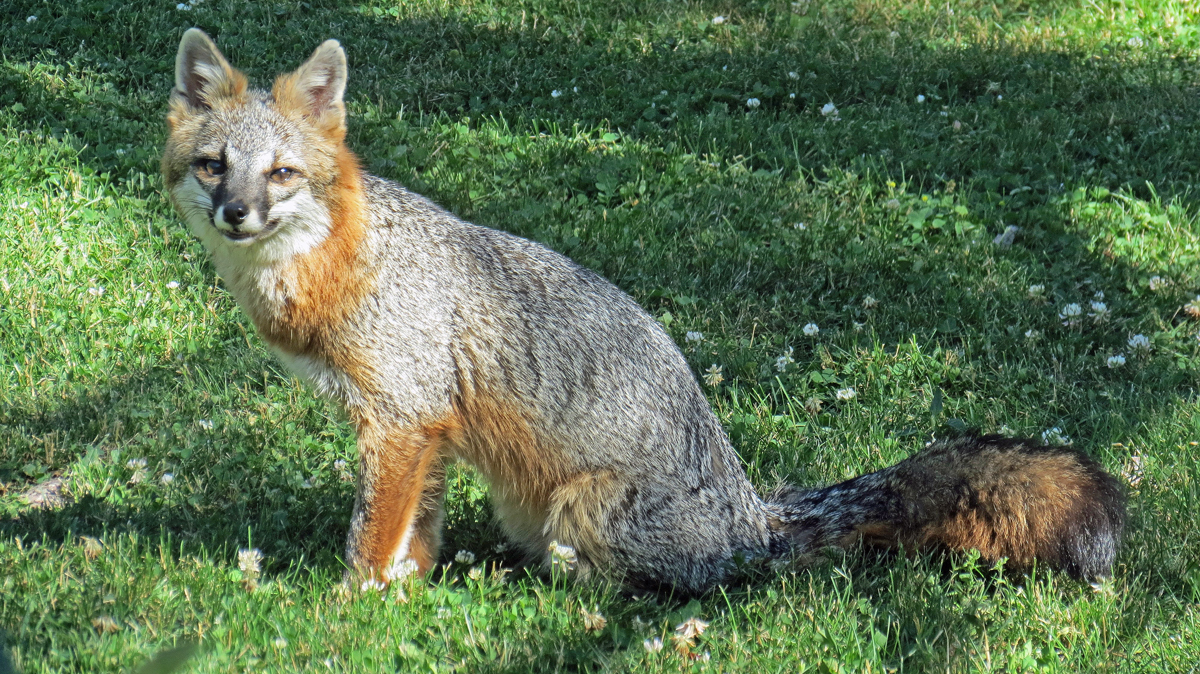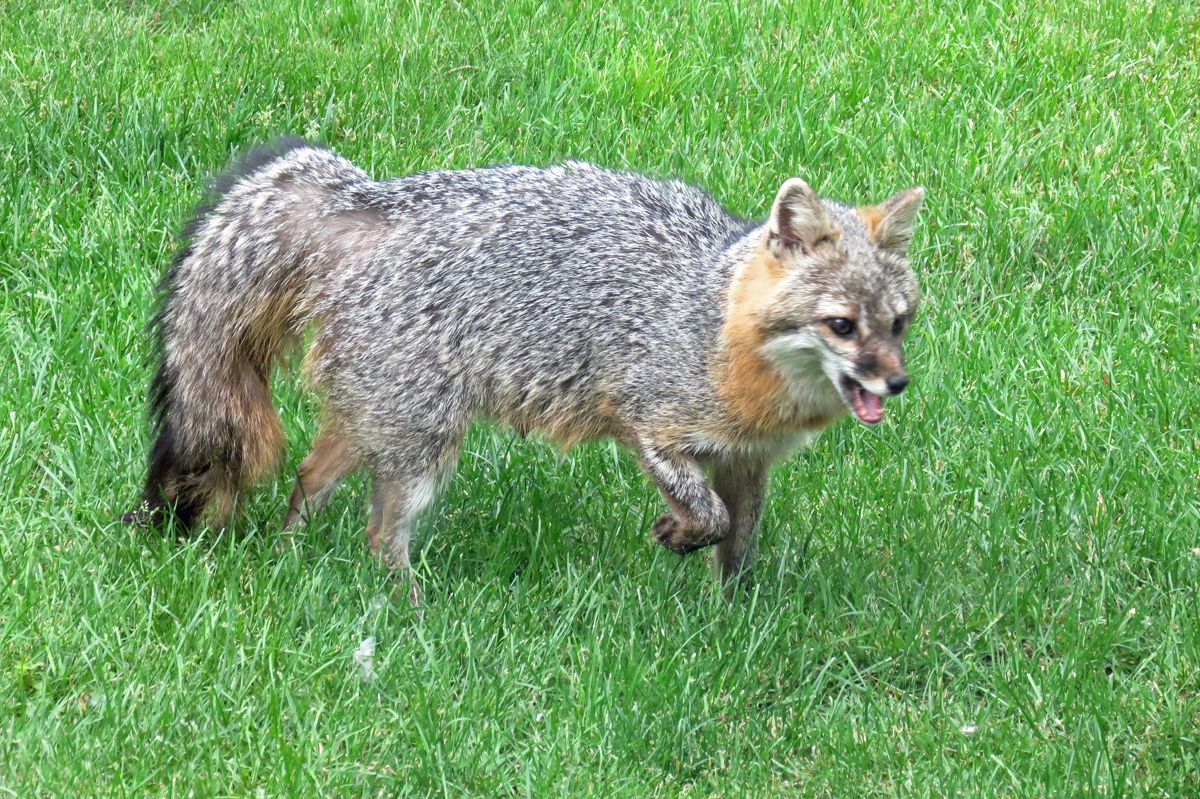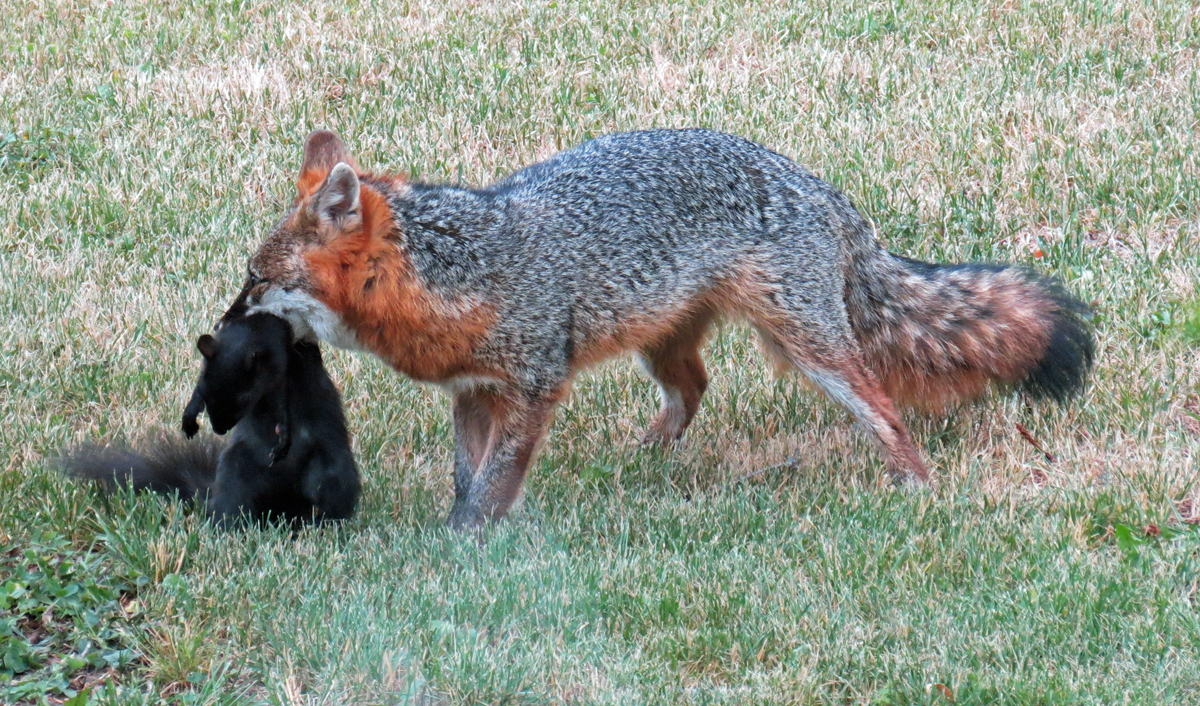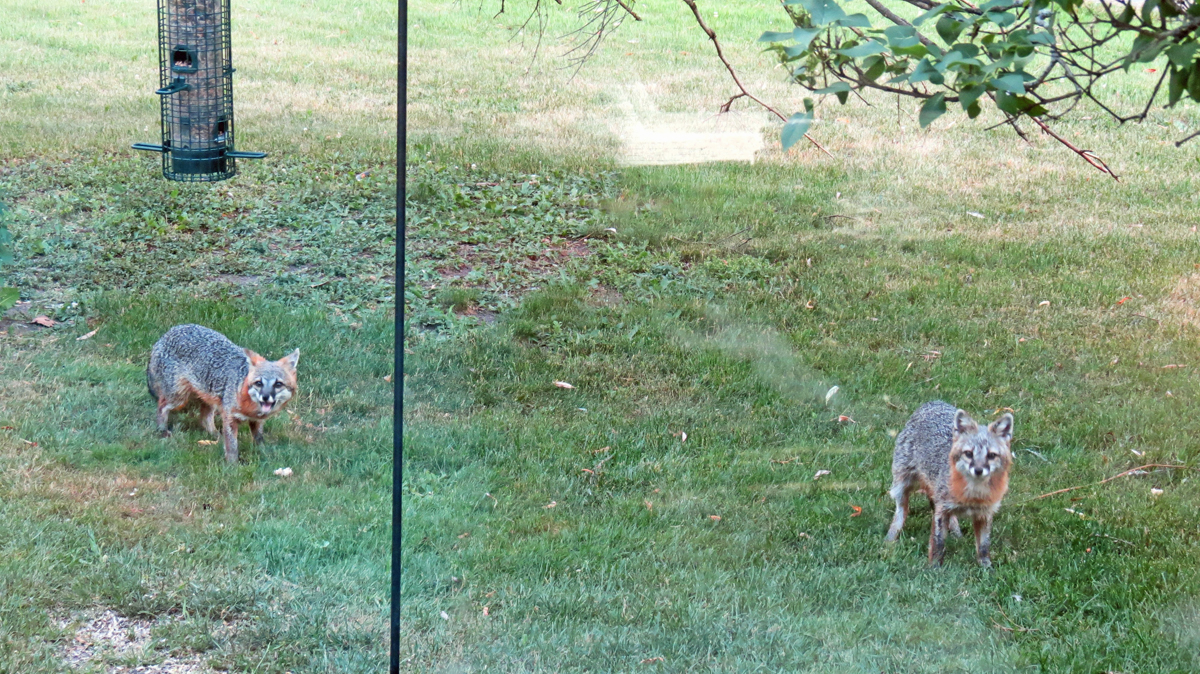Prince Edward County, Ontario, Canada
Thurlow Gray Fox Makes Rare Appearance
GRAY FOX, NORTH OF BELLEVILLE, FEELS RIGHT AT HOME IN THURLOW BACKYARD
(all photos by Fiona King) When Fiona and Bernie King, who reside north of Belleville, dumped out some old brown rice and stale cereal, in May, they thought, at least, that it might appeal to their birds, and not be totally wasted. That it might attract something special to their backyard, like a threatened species, never crossed their mind. Upon hearing some barking and growling, they flipped on the outside light to see what had appeared, and were surprised to see this Gray Fox (Urocyon cinereoargenteus). Fiona grabbed her camera and managed to get a few grainy pictures in the poor light conditions. However, the photos were sharp enough to convince Lisa Solomon, Management Biologist with the Peterborough District of the Ontario Ministry of Natural Resources, that this was definitely a Gray Fox, urging her to submit the photo to the Natural Heritage Information Centre, an agency that manages data about the location of species of conservation concern, plant communities, wildlife concentration areas, and natural areas in Ontario. The Centre assigns conservation status ranks to species, plant communities and wildlife concentration areas in Ontario. These ranks are then used by the province, national organizations and international organizations to help assign legal statuses and other conservation designations.
When Fiona and Bernie King, who reside north of Belleville, dumped out some old brown rice and stale cereal, in May, they thought, at least, that it might appeal to their birds, and not be totally wasted. That it might attract something special to their backyard, like a threatened species, never crossed their mind. Upon hearing some barking and growling, they flipped on the outside light to see what had appeared, and were surprised to see this Gray Fox (Urocyon cinereoargenteus). Fiona grabbed her camera and managed to get a few grainy pictures in the poor light conditions. However, the photos were sharp enough to convince Lisa Solomon, Management Biologist with the Peterborough District of the Ontario Ministry of Natural Resources, that this was definitely a Gray Fox, urging her to submit the photo to the Natural Heritage Information Centre, an agency that manages data about the location of species of conservation concern, plant communities, wildlife concentration areas, and natural areas in Ontario. The Centre assigns conservation status ranks to species, plant communities and wildlife concentration areas in Ontario. These ranks are then used by the province, national organizations and international organizations to help assign legal statuses and other conservation designations.  Superficially very similar to our familiar Red Fox (Vulpes vulpes), there are several characteristics that make it possible to reliably differentiate the two species. The Gray Fox has a shorter muzzle, shorter legs, and more rounded footprints than the Red Fox. Most of its fur is a grizzled grey colour, with cinnamon-coloured patches limited to parts of the neck, sides, and legs. A prominent black stripe runs the length of the Gray Fox’s back down to, and including, the tip of its tail. In contrast, the Red Fox usually has a rusty red coat and a white tail tip. There is white fur on the ears, face, throat, chest, belly and hind legs. There is also a distinctive black muzzle patch in front of each eye and on the lower jaw. The Gray Fox also has shorter legs than the Red Fox, although it is of a similar mass. The Gray Fox has a shorter muzzle, rounder footprints, larger toe pads and more curved claws than the Red Fox. The Gray Fox should not be confused with the Cross Fox and the Black or Silver Fox which are just melanistic colour variants of our more familiar Red Fox. During the compilation of material for the 1994 Atlas of the Mammals of Ontario, the Gray Fox was regarded as “a rare species on the provincial status list”.
Superficially very similar to our familiar Red Fox (Vulpes vulpes), there are several characteristics that make it possible to reliably differentiate the two species. The Gray Fox has a shorter muzzle, shorter legs, and more rounded footprints than the Red Fox. Most of its fur is a grizzled grey colour, with cinnamon-coloured patches limited to parts of the neck, sides, and legs. A prominent black stripe runs the length of the Gray Fox’s back down to, and including, the tip of its tail. In contrast, the Red Fox usually has a rusty red coat and a white tail tip. There is white fur on the ears, face, throat, chest, belly and hind legs. There is also a distinctive black muzzle patch in front of each eye and on the lower jaw. The Gray Fox also has shorter legs than the Red Fox, although it is of a similar mass. The Gray Fox has a shorter muzzle, rounder footprints, larger toe pads and more curved claws than the Red Fox. The Gray Fox should not be confused with the Cross Fox and the Black or Silver Fox which are just melanistic colour variants of our more familiar Red Fox. During the compilation of material for the 1994 Atlas of the Mammals of Ontario, the Gray Fox was regarded as “a rare species on the provincial status list”.  What makes the Belleville area sighting so significant is that the Gray Fox is not expected to occur here. The Gray Fox is typically found in warmer climates. In Canada, harsh winters usually prevents it from moving very far northward. Gray Foxes were once abundant in eastern Canada, but they disappeared 300 years ago, before the arrival of European settlers. Since 1900 though, the species has gradually extended its range into previously unoccupied areas in the Great Lakes region of Canada and the United States, but there are no data after the 1940s that would support either a population increase or decline in Canada, says one website. Breeding in Canada has been confirmed only on Pelee Island, Ontario, where the population consists of approximately 60 individuals, with perhaps 12 to 15 breeding pairs. Between 1980 and 2000, typically fewer than 10 Gray Foxes a year were reported caught in traps set for Red Foxes in Ontario. In Ontario, its historic range was across the southernmost portions of the province, although there have been occasional sightings and reports of the Gray Fox close to the U.S. border in the Niagara, Thousand Islands and Windsor areas. In Ontario, the Gray Fox lives in deciduous forests and marshes. Gray Fox dens are usually found in dense shrubs close to a water source but they will also use rocky areas, hollow trees, and underground burrows dug by other animals. This species will live in many types of habitat provided there is sufficient shelter and prey availability.
What makes the Belleville area sighting so significant is that the Gray Fox is not expected to occur here. The Gray Fox is typically found in warmer climates. In Canada, harsh winters usually prevents it from moving very far northward. Gray Foxes were once abundant in eastern Canada, but they disappeared 300 years ago, before the arrival of European settlers. Since 1900 though, the species has gradually extended its range into previously unoccupied areas in the Great Lakes region of Canada and the United States, but there are no data after the 1940s that would support either a population increase or decline in Canada, says one website. Breeding in Canada has been confirmed only on Pelee Island, Ontario, where the population consists of approximately 60 individuals, with perhaps 12 to 15 breeding pairs. Between 1980 and 2000, typically fewer than 10 Gray Foxes a year were reported caught in traps set for Red Foxes in Ontario. In Ontario, its historic range was across the southernmost portions of the province, although there have been occasional sightings and reports of the Gray Fox close to the U.S. border in the Niagara, Thousand Islands and Windsor areas. In Ontario, the Gray Fox lives in deciduous forests and marshes. Gray Fox dens are usually found in dense shrubs close to a water source but they will also use rocky areas, hollow trees, and underground burrows dug by other animals. This species will live in many types of habitat provided there is sufficient shelter and prey availability.  What makes the Belleville area sighting that much more interesting is that one of the individuals photographed had very enlarged teats! The Atlas states that no records exist of a Gray Fox having produced a litter in Ontario (except on Pelee Island)! So, the Belleville area sighting might not only be the Belleville area’s first sighting of the rare Gray Fox in the Bay of Quinte region, but may very well constitute the first breeding record for mainland Ontario! Fiona King continues, “We can now very easily distinguish one from the other as we see them in daylight on a daily basis. One of the two (paler in colour) has very enlarged teats!! We are quite sure there was a third, much smaller fox a couple of nights ago. So, it seems that we have a breeding population of Gray Fox here!” The new arrivals have been coming out in broad daylight quite consistently for the last two or three weeks. Their goal now is to determine whether both are females or maybe a male and a female. Definitely size, coat, and temperament difference, she notes. “We are delighted and hope this means that the Gray Foxes are residing here and not just passing through.” The Kings are eager to receive any reports of sightings of a Gray Fox in their area in order to get a better feel for their population status in the Bay of Quinte region. Sightings or further information on the Gray Fox can be sent to my contact email address, and I will forward your information to the Kings. Be sure to put “GRAY FOX” in the subject line of your e-mail message.
What makes the Belleville area sighting that much more interesting is that one of the individuals photographed had very enlarged teats! The Atlas states that no records exist of a Gray Fox having produced a litter in Ontario (except on Pelee Island)! So, the Belleville area sighting might not only be the Belleville area’s first sighting of the rare Gray Fox in the Bay of Quinte region, but may very well constitute the first breeding record for mainland Ontario! Fiona King continues, “We can now very easily distinguish one from the other as we see them in daylight on a daily basis. One of the two (paler in colour) has very enlarged teats!! We are quite sure there was a third, much smaller fox a couple of nights ago. So, it seems that we have a breeding population of Gray Fox here!” The new arrivals have been coming out in broad daylight quite consistently for the last two or three weeks. Their goal now is to determine whether both are females or maybe a male and a female. Definitely size, coat, and temperament difference, she notes. “We are delighted and hope this means that the Gray Foxes are residing here and not just passing through.” The Kings are eager to receive any reports of sightings of a Gray Fox in their area in order to get a better feel for their population status in the Bay of Quinte region. Sightings or further information on the Gray Fox can be sent to my contact email address, and I will forward your information to the Kings. Be sure to put “GRAY FOX” in the subject line of your e-mail message.